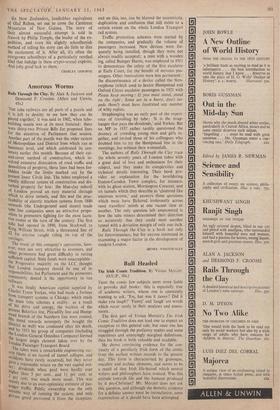Amorous Worms
THE tube railways are all parts of a puzzle and it is left to destiny to see how they can be Pieced together,' it was said in 1902, when tube- building mania was at its most frenzied: there were thirty-two Private Bills for proposed lines for the attention of Parliament that session. Another part of the puzzle was the older system Of. Metropolitan and District lines which ran at basement level, and which celebrated its cen- tenary earlier this month. Because of their cut- and-cover method of construction, which in- volved extensive dislocation of road traffic and demolition of property, these lines had been for- bidden inside the limits marked out by the Present Inner Circle line. The tubes employed a Wholly different system of construction and dis- turbed property far less: the blue-clay subsoil of London proved an easy material through Which to drive tunnels, and this and the prac- ticability of electric traction systems from 1880 onwards (the Underground used steam) made tube line companies seem an attractive propo- sition to promoters fighting for the most lucra- tive routes at the turn of the century. The first tube had opened in 1890, from Stockwell to King William Street, with a threatened fine of £2 for anyone caught riding on top of the carriages. The result of this company's operations, how- ever, were not very attractive to investors, and other promoters had great difficulty in raising sufficient capital. State funds were unacceptable: the Progressive majority on the LCC thought that London transport should be one of its responsibilities, but Parliament and the promoters consistently denied it the opportunity to run railways.
It was finally American capital supplied by Charles Tyson Yerkes, who had made a fortune from transport systems in Chicago, which made the main tube schemes a reality : as a result of his drive and energy, the nucleus of the present Bakerloo line, Piccadilly line and Hamp- stead branch of the Northern line were created. His trend towards monopoly (he bought the District as well) was continued after his death, the London by 1933 his group of companies (including
London General Omnibus Company) formed the e largest single element taken over by the London Passenger Transport Board. _ The tubes were a remarkable engineering suc- cess (there is no record of tunnel collapse, and accidents have rarely occurred), but they never Save a reasonable return on the vast capital out-
dividends when paid were hardly ever higher than 5 per cent., and 11 per cent. or 4 Per cent, was much more usual. This was ni „ ainlY due to an over-optimistic estimate of pas- senger traffic. Public ownership was the only sensible way of running the system, and only private greed prevented it from the inception; and on this, too, can be blamed the eccentricity, duplication and confusion that still exists to a certain extent on the whole London Transport rail system.
Traffic promotion schemes were started by the companies, and gradually the volume of passengers increased. New devices were fre- quently being installed, though they were not always readily accepted: a man with a wooden leg, called Bumper Harris, was employed in 1911 to demonstrate the safety of the first escalator at Earls Court, for the benefit of nervous pas- sengers. Other innovations were less permanent : the discontinuance of a device called the Sten- torphone (which used to hector Hampstead and Oxford Circus escalator passengers in 1921 with Please keep moving : If you must stand, stand on the right : Some are in a hurry, don't im- pede them!) must have frustrated any number of witty replies.
Straphanging was an early part of the experi- ence of travelling by tube: 'It is the strap- hanger that pays the dividends,' said Yerkes. But an. MP in 1937 rather tardily questioned the decency of crowding young men and girls to- gether, and' invited those of his colleagues who doubted him to try the Hampstead line in the mornings; but without their womenfolk.
The authors of Rails Through the Clay trace the whole seventy years of London tubes with a great deal of love and enthusiasm for their subject, and they make its complexities and technical details interesting. Their book pro- vides an explanation for the bewildering Euston-Camden Town complex, for instance, with its ghost station, Momington Crescent, and six tunnels which they describe as 'clustered like amorous worms,' and answers those questions which must have flickered irrelevantly across most travellers' minds at one vacant time or another. The only question left unanswered is how the tube miners determined their direction so • accurately that they could meet another tunnel with a deviation margin of only one inch.
Rails Through the Clay is a book not only for ferrovimaniacs, but for anyone interested in examining a major factor in the development of modern London.
HENRY WRIOTHESLEY


































 Previous page
Previous page